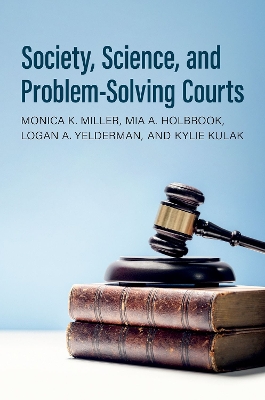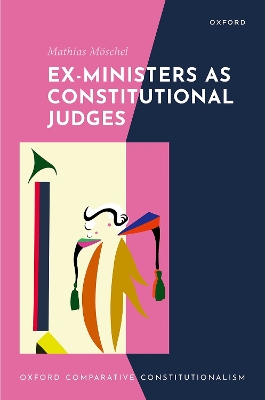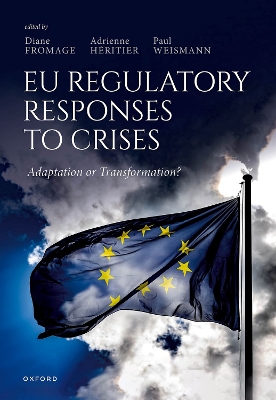Society, Science, and Problem-Solving Courts
 -10%
portes grátis
-10%
portes grátis
Society, Science, and Problem-Solving Courts
Kulak, Kylie; Miller, Monica K.; Yelderman, Logan A.; Holbrook, Mia A.
Oxford University Press Inc
02/2025
352
Dura
9780190059804
15 a 20 dias
Descrição não disponível.
Section 1: Introduction to Problem-Solving Courts
Chapter 1: Society, Science, and Problem-solving Courts in the U.S. and Abroad
Chapter 2: Overview of the Types of Problem-Solving Courts
Mia A. Holbrook and Mary Dhondt
Section 2: The Science of Problem-Solving Courts
Chapter 3: The Justice Principles of Problem-Solving Courts
Logan A. Yelderman, Mia A. Holbrook, Jennifer L. Lanterman, Alicia DeVault, Monica K. Miller
Chapter 4:The Psychology of Problem-Solving Courts
Chapter 5: Scientific Methodology used in Evaluations and Problem-Solving Courts
Chapter 6: Effectiveness of Problem-Solving Courts
Mia A. Holbrook and Mary Dhondt
Section 3: Society and Problem-Solving Courts
Chapter 7: When Law and Culture Collide
Chapter 8: Problem-Solving Courts and the Social Mind-set Model
Monica K Miller, Kylie Kulak, and Amber Westbrook
Section 4: The Development (or Not) of Problem-solving Courts
Chapter 9: Why Some Countries Have Problem-solving Courts
Waleed Jami, Kylie Kulak, and Monica K. Miller
Chapter 10: Why Some Countries Do Not Have Problem-solving Courts
Section 5: Problem-solving Courts: Looking to the Future by Looking at the Past
Chapter 11: The Benefits (Pros) and Drawbacks (Cons) of Problem-Solving Courts: A Scientific Understanding of Variations in Perspectives Across Societies
Conclusion
Chapter 12: Society, Science, and Problem-solving Courts: Yesterday, Today, and Tomorrow
References
Chapter 1: Society, Science, and Problem-solving Courts in the U.S. and Abroad
Chapter 2: Overview of the Types of Problem-Solving Courts
Mia A. Holbrook and Mary Dhondt
Section 2: The Science of Problem-Solving Courts
Chapter 3: The Justice Principles of Problem-Solving Courts
Logan A. Yelderman, Mia A. Holbrook, Jennifer L. Lanterman, Alicia DeVault, Monica K. Miller
Chapter 4:The Psychology of Problem-Solving Courts
Chapter 5: Scientific Methodology used in Evaluations and Problem-Solving Courts
Chapter 6: Effectiveness of Problem-Solving Courts
Mia A. Holbrook and Mary Dhondt
Section 3: Society and Problem-Solving Courts
Chapter 7: When Law and Culture Collide
Chapter 8: Problem-Solving Courts and the Social Mind-set Model
Monica K Miller, Kylie Kulak, and Amber Westbrook
Section 4: The Development (or Not) of Problem-solving Courts
Chapter 9: Why Some Countries Have Problem-solving Courts
Waleed Jami, Kylie Kulak, and Monica K. Miller
Chapter 10: Why Some Countries Do Not Have Problem-solving Courts
Section 5: Problem-solving Courts: Looking to the Future by Looking at the Past
Chapter 11: The Benefits (Pros) and Drawbacks (Cons) of Problem-Solving Courts: A Scientific Understanding of Variations in Perspectives Across Societies
Conclusion
Chapter 12: Society, Science, and Problem-solving Courts: Yesterday, Today, and Tomorrow
References
Este título pertence ao(s) assunto(s) indicados(s). Para ver outros títulos clique no assunto desejado.
Section 1: Introduction to Problem-Solving Courts
Chapter 1: Society, Science, and Problem-solving Courts in the U.S. and Abroad
Chapter 2: Overview of the Types of Problem-Solving Courts
Mia A. Holbrook and Mary Dhondt
Section 2: The Science of Problem-Solving Courts
Chapter 3: The Justice Principles of Problem-Solving Courts
Logan A. Yelderman, Mia A. Holbrook, Jennifer L. Lanterman, Alicia DeVault, Monica K. Miller
Chapter 4:The Psychology of Problem-Solving Courts
Chapter 5: Scientific Methodology used in Evaluations and Problem-Solving Courts
Chapter 6: Effectiveness of Problem-Solving Courts
Mia A. Holbrook and Mary Dhondt
Section 3: Society and Problem-Solving Courts
Chapter 7: When Law and Culture Collide
Chapter 8: Problem-Solving Courts and the Social Mind-set Model
Monica K Miller, Kylie Kulak, and Amber Westbrook
Section 4: The Development (or Not) of Problem-solving Courts
Chapter 9: Why Some Countries Have Problem-solving Courts
Waleed Jami, Kylie Kulak, and Monica K. Miller
Chapter 10: Why Some Countries Do Not Have Problem-solving Courts
Section 5: Problem-solving Courts: Looking to the Future by Looking at the Past
Chapter 11: The Benefits (Pros) and Drawbacks (Cons) of Problem-Solving Courts: A Scientific Understanding of Variations in Perspectives Across Societies
Conclusion
Chapter 12: Society, Science, and Problem-solving Courts: Yesterday, Today, and Tomorrow
References
Chapter 1: Society, Science, and Problem-solving Courts in the U.S. and Abroad
Chapter 2: Overview of the Types of Problem-Solving Courts
Mia A. Holbrook and Mary Dhondt
Section 2: The Science of Problem-Solving Courts
Chapter 3: The Justice Principles of Problem-Solving Courts
Logan A. Yelderman, Mia A. Holbrook, Jennifer L. Lanterman, Alicia DeVault, Monica K. Miller
Chapter 4:The Psychology of Problem-Solving Courts
Chapter 5: Scientific Methodology used in Evaluations and Problem-Solving Courts
Chapter 6: Effectiveness of Problem-Solving Courts
Mia A. Holbrook and Mary Dhondt
Section 3: Society and Problem-Solving Courts
Chapter 7: When Law and Culture Collide
Chapter 8: Problem-Solving Courts and the Social Mind-set Model
Monica K Miller, Kylie Kulak, and Amber Westbrook
Section 4: The Development (or Not) of Problem-solving Courts
Chapter 9: Why Some Countries Have Problem-solving Courts
Waleed Jami, Kylie Kulak, and Monica K. Miller
Chapter 10: Why Some Countries Do Not Have Problem-solving Courts
Section 5: Problem-solving Courts: Looking to the Future by Looking at the Past
Chapter 11: The Benefits (Pros) and Drawbacks (Cons) of Problem-Solving Courts: A Scientific Understanding of Variations in Perspectives Across Societies
Conclusion
Chapter 12: Society, Science, and Problem-solving Courts: Yesterday, Today, and Tomorrow
References
Este título pertence ao(s) assunto(s) indicados(s). Para ver outros títulos clique no assunto desejado.







